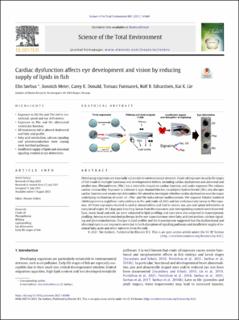Cardiac dysfunction affects eye development and vision by reducing supply of lipids in fish
Sørhus, Elin; Meier, Sonnich; Donald, Carey; Furmanek, Tomasz; Edvardsen, Rolf Brudvik; Lie, Kai Kristoffer
Peer reviewed, Journal article
Published version
Date
2021Metadata
Show full item recordCollections
- Articles [3012]
- Publikasjoner fra CRIStin [3066]
Original version
10.1016/j.scitotenv.2021.149460Abstract
Developing organisms are especially vulnerable to environmental stressors. Crude oil exposure in early life stages of fish result in multiple functional and developmental defects, including cardiac dysfunction and abnormal and smaller eyes. Phenanthrene (Phe) has a reversible impact on cardiac function, and under exposure Phe reduces cardiac contractility. Exposure to a known L-type channel blocker, nicardipine hydrochloride (Nic) also disrupts cardiac function and creates eye deformities. We aimed to investigate whether cardiac dysfunction was the major underlying mechanism of crude oil-, Phe- and Nic-induced eye malformations. We exposed Atlantic haddock (Melanogrammus aeglefinus) early embryos to Nic and crude oil (Oil) and late embryos/early larvae to Phe exposure. All three exposures resulted in cardiac abnormalities and lead to severe, eye, jaw and spinal deformities at early larval stages. At 3 days post hatching, larvae from the exposures and corresponding controls were dissected. Eyes, trunk, head and yolk sac were subjected to lipid profiling, and eyes were also subjected to transcriptomic profiling. Among most enriched pathways in the eye transcriptomes were fatty acid metabolism, calcium signaling and phototransduction. Changes in lipid profiles and the transcriptome suggested that the dysfunctional and abnormal eyes in our exposures were due to both disruption of signaling pathways and insufficient supply of essential fatty acids and other nutrients form the yolk.
